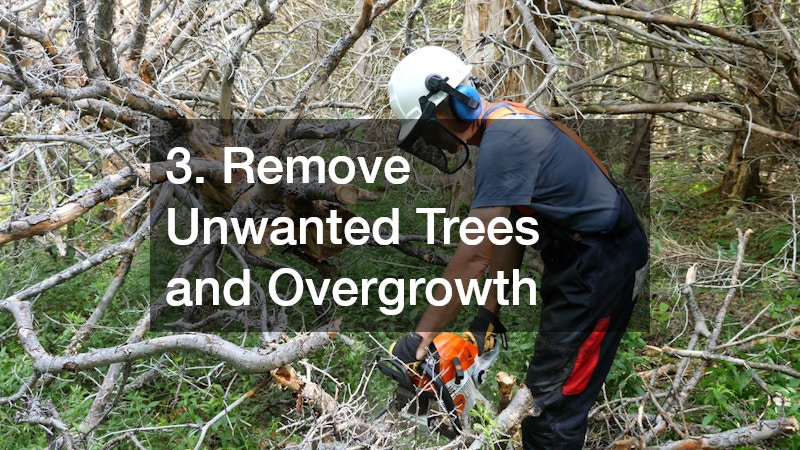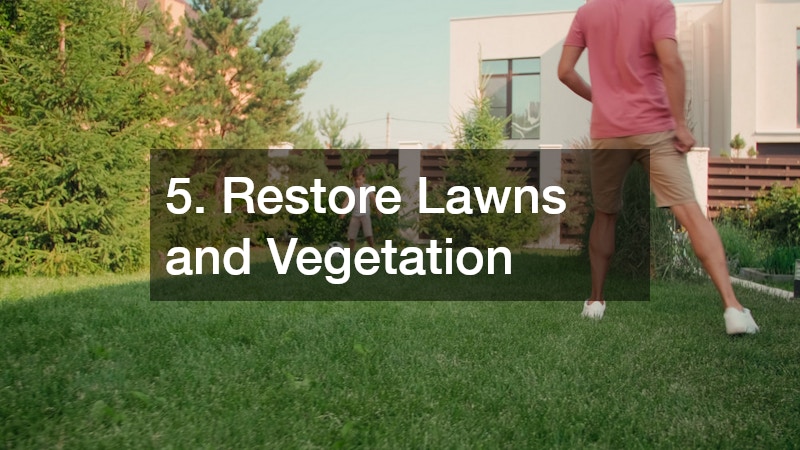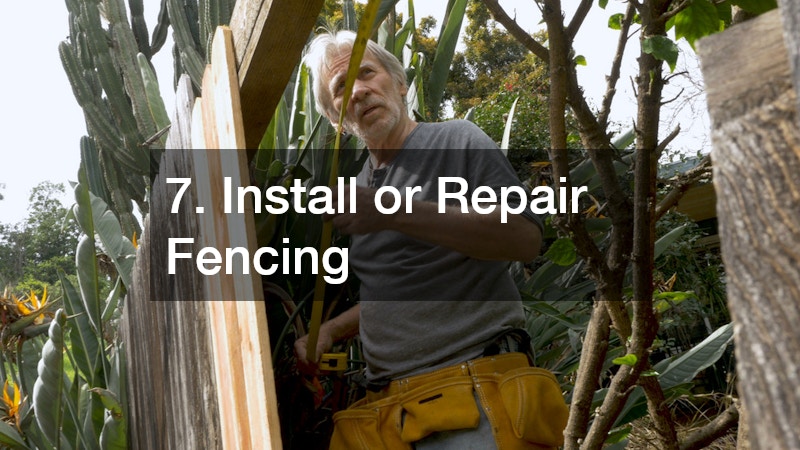
Overgrown properties can feel overwhelming, cluttered, and uninviting. Left unchecked, tall weeds, tangled shrubs, and encroaching trees can create safety hazards, attract pests, and diminish the overall value and enjoyment of your land. Clearing an overgrown yard isn’t just about aesthetics—it’s about reclaiming control over your property, creating usable outdoor space, and setting the stage for future landscaping improvements.
The process can feel intimidating, especially if a property has been neglected for years. But with the right strategies, tools, and professional support, transforming a yard doesn’t have to be an impossible task. From identifying priority areas to removing debris and managing plant growth, there are practical steps homeowners can take to regain a safe, functional, and attractive outdoor space. This guide walks through multiple ideas for tackling overgrown properties, emphasizing both DIY options and when to call in professionals to ensure a lasting result.
1. Evaluate and Plan Your Yard Clearing

Before starting any physical work, it’s crucial to assess the yard thoroughly. Understanding the scope of overgrowth, identifying hazards, and prioritizing areas for clearing helps prevent wasted effort and unexpected challenges. Consider the placement of trees, shrubs, fences, and pathways, as well as any drainage or structural concerns. A solid plan ensures you approach the work efficiently, avoiding potential damage to desirable landscaping features or underground utilities.
Planning also involves deciding which areas you can tackle yourself and where professional help may be needed. For large or heavily overgrown properties, services like land clearing can make a huge difference. These professionals have the equipment and expertise to remove dense vegetation, fallen trees, and unwanted undergrowth safely. Even with professional assistance, having a clear plan ensures that your yard transformation aligns with your overall goals, whether you want a clean, open space, functional zones for recreation, or preparation for future landscaping. Proper evaluation and planning save time, reduce frustration, and set the stage for a smoother, more satisfying property clearing process.
2. Manage Drainage Issues Early
Proper drainage is often overlooked but is critical when reclaiming overgrown land. Poor drainage can cause standing water, erode soil, and damage plant life, creating recurring problems even after cleanup. Addressing drainage concerns early helps ensure that cleared areas remain functional and free from future overgrowth.
Working with a drainage company can be invaluable, especially on properties with complex grading, slopes, or recurring water issues. Professionals can design systems that divert water efficiently, protect soil structure, and prevent damage to foundations or fences. Simple measures, like installing French drains or grading the yard to guide water away from critical areas, can have a long-term impact. Proper drainage not only prevents erosion and plant damage but also supports the success of future landscaping projects, paving, or lawn improvements. Tackling drainage at the outset reduces maintenance and sets a solid foundation for a cleaner, healthier, and more attractive yard.
3. Remove Unwanted Trees and Overgrowth

Trees can add beauty, shade, and privacy, but unmanaged growth can dominate a yard, block sunlight, and damage other plants or structures. Overgrown trees may require professional attention to ensure safe removal or trimming.
Tree services can assess which trees need pruning, removal, or treatment to restore balance and safety to the yard. Professionals are equipped to handle large limbs, hazardous trunks, and difficult-to-access areas, minimizing the risk of injury or property damage. Even small trees, if left unchecked, can spread roots, create shade problems, and compete with other landscaping elements. Removing or managing overgrown trees not only opens up the space but also enhances sunlight, improves airflow, and reduces debris accumulation. Proper tree care during yard clearing lays the groundwork for a more organized, functional, and visually appealing property.
4. Grind Stumps and Clear Root Debris
After removing trees, stumps and their associated root systems often remain as stubborn obstacles that can interfere with landscaping, mowing, paving, and even drainage improvements. These remnants aren’t just unsightly—they can create safety hazards, such as tripping points, and may also attract pests like termites or ants, which can spread to nearby structures or garden areas. Additionally, exposed stumps can make a yard look neglected, diminishing the overall appeal of your property even after larger clearing efforts have been completed.
Stump grinding is an efficient and safe solution for removing these lingering tree bases. Using specialized machinery, professionals grind the stump down below ground level, often reducing it to mulch or sawdust in the process. This allows the area to be regraded, leveled, and prepared for new plantings, paving projects, or lawn restoration. Beyond aesthetics, stump grinding also prevents regrowth of the tree or sprouts that may compromise future landscaping plans.
5. Restore Lawns and Vegetation

Once trees and overgrowth are removed, the focus naturally shifts to the lawn and any remaining vegetation. Overgrown yards often suffer from uneven grass, bare patches, invasive weeds, and unmanaged growth, all of which can make the property look neglected and uninviting. Ignoring these issues can also contribute to soil erosion, poor drainage, and the rapid return of overgrowth in cleared areas. Addressing lawn health early in the clearing process is essential to creating a functional, attractive outdoor space.
Engaging a professional lawn care service can be a game-changer in restoring a yard to its full potential. Experts assess soil quality, identify problem areas, and recommend treatments such as fertilization, aeration, or targeted seeding to promote robust growth. They can also help control weeds, pests, and fungal issues that commonly appear in neglected lawns. In addition to improving visual appeal, a healthy lawn creates a solid foundation for landscaping, paving, and garden projects while helping with drainage and soil stabilization.
Regular mowing, consistent watering, and proactive weed management keep the lawn looking uniform and healthy. Applying mulch around trees or garden beds complements the lawn, retaining moisture and reducing maintenance needs. Over time, consistent care transforms bare, patchy areas into lush, green spaces that enhance the overall appearance of the property. A revitalized lawn not only improves curb appeal but also contributes to a safer and more functional yard, supporting outdoor activities and future landscaping upgrades.
6. Apply Mulch to Protect Soil and Plantings
After clearing and restoring key areas, applying mulch can enhance the appearance of garden beds, prevent weed regrowth, and improve soil health. Mulch acts as a barrier against erosion, retains moisture, and provides a finished look that ties the yard together.
Proper placement and selection of mulch are important. Organic options, like bark or wood chips, decompose over time, enriching the soil, while inorganic alternatives can offer longer-lasting coverage in high-traffic areas. Mulching not only reduces future maintenance but also gives cleared yards a cohesive, well-maintained appearance. In combination with tree care, lawn restoration, and planting, mulch reinforces a clean and polished look that mimics professional landscaping. Even on a budget, strategic mulching is a simple but highly effective way to make an overgrown yard feel revitalized and cared for.
7. Install or Repair Fencing

Clearing overgrown properties often uncovers damaged, leaning, or completely missing fences that were previously hidden by vegetation. Without clearly defined boundaries, a yard can feel chaotic, unorganized, and less secure. Reestablishing fencing is not just about aesthetics—it serves multiple practical purposes. A sturdy fence provides security, deters trespassers, keeps pets and children safe, and clearly marks property lines, which can prevent disputes with neighbors. Well-maintained fencing also contributes significantly to the overall curb appeal, giving a property a polished and cared-for appearance that enhances its value.
Wood fence companies specialize in installing or repairing various types of fencing that are both durable and visually appealing. Depending on your property, repairs may involve replacing rotten boards, reinforcing posts, or installing entirely new sections. Wood fences also create a backdrop that makes landscaping features like flower beds, paving, and trees stand out. Even partial updates or repairs contribute to a more structured and aesthetically pleasing yard. Working with professionals ensures fences are level, sturdy, and long-lasting, complementing the cleared property and helping maintain a tidy, organized space.
8. Remove Debris and Trash Efficiently
After clearing overgrown vegetation, homeowners are often left with a substantial amount of debris, including branches, leaves, brush, and other discarded materials that have accumulated over months or even years. This debris can create multiple problems if not addressed promptly. Piles of organic matter may attract pests, including rodents and insects, while scattered branches and sharp objects can pose safety hazards for anyone navigating the yard. In addition, leftover debris can hinder mowing, landscaping, and future projects like paving or garden installation. Efficient removal is therefore essential not only for safety but also to prepare the yard for long-term use and enjoyment.
Dumpster rentals provide a practical solution for disposing of large amounts of waste quickly. They allow homeowners to collect branches, old fencing, and other debris in one centralized location for convenient pickup. Using rentals simplifies the cleanup process, reducing the number of trips to disposal sites and keeping the property manageable during and after the clearing process. Combined with professional tree and stump services, efficient debris removal ensures that the cleared yard remains accessible, functional, and visually appealing, setting the stage for further landscaping or paving projects.
9. Consider Paving Key Areas
Once the yard has been cleared of overgrowth, debris, and obstacles, adding paving can significantly enhance both the functionality and aesthetic appeal of the property. Paving transforms areas that were once difficult to navigate into clean, organized, and usable spaces. Driveways, walkways, patios, and seating areas all benefit from well-laid surfaces, which make the yard more accessible, safer to traverse, and easier to maintain. Without proper paving, cleared areas may be prone to mud, erosion, or uneven footing, which can undermine the effort spent reclaiming the property.
Professional paving services can recommend materials and layouts that suit your property’s needs and budget. Properly installed paving prevents erosion, controls drainage, and provides a clean, polished appearance that contrasts with the cleared natural areas. Even modest paving projects, such as stepping stones or compacted gravel paths, add structure and accessibility, making the yard more enjoyable for everyday use. Strategic paving complements lawn areas, fences, and garden beds, reinforcing a cohesive look while minimizing long-term maintenance.
10. Address Pest Concerns
Overgrown properties often harbor unwanted pests such as insects, rodents, or other wildlife. After clearing vegetation, taking steps to prevent infestations is important for both safety and property maintenance.
Exterminators can inspect the property, identify problem areas, and apply targeted solutions to keep pests under control. This includes treating soil, inspecting fence lines, and managing areas prone to standing water or debris accumulation. Addressing pest concerns ensures that the newly cleared yard remains usable and safe, protecting both plants and structures. It also prevents future growth or damage that could undo the hard work of clearing and restoring the property. Proactive pest management is a critical step in maintaining a functional, attractive, and healthy yard.
11. Maintain and Plan for Future Growth
The final step in transforming an overgrown property is ongoing maintenance. Establishing a routine ensures the yard remains clean, functional, and visually appealing over time. Regular mowing, pruning, debris removal, and monitoring of drainage, plants, and fencing are essential to prevent overgrowth from returning.
Ongoing care reinforces all previous efforts, allowing investments in land clearing, tree services, stump grinding, and paving to last longer. It also makes it easier to implement additional landscaping improvements, such as planting new vegetation, installing mulch, or expanding garden beds. Thoughtful maintenance protects your property value, reduces safety hazards, and keeps your yard a welcoming, functional space. By combining clearing, professional support, and routine care, homeowners can turn even the most neglected lot into a vibrant and usable outdoor space.
Transforming an overgrown property requires careful planning, strategic investment, and sometimes professional assistance. From addressing drainage issues to removing trees, grinding stumps, restoring lawns, applying mulch, installing fences, and managing pests, each step plays a crucial role in reclaiming a neglected yard. Efficient debris removal, thoughtful paving, and ongoing maintenance ensure that the cleared space remains functional and visually appealing.
By prioritizing high-impact improvements and leveraging professional services, homeowners can achieve a polished, usable, and inviting yard without excessive cost. Even small steps contribute to a significant transformation, making overgrown lots safe, attractive, and enjoyable. With proper planning, effort, and selective investments, it’s possible to turn any neglected property into a beautiful, functional outdoor area that enhances both daily living and property value.
